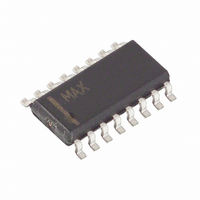MAX1653ESE Maxim Integrated Products, MAX1653ESE Datasheet - Page 22

MAX1653ESE
Manufacturer Part Number
MAX1653ESE
Description
IC CTRLR DCDC PWM STPDWN 16-SOIC
Manufacturer
Maxim Integrated Products
Type
Step-Down (Buck)r
Datasheet
1.MAX1655ESE.pdf
(28 pages)
Specifications of MAX1653ESE
Internal Switch(s)
No
Synchronous Rectifier
Yes
Number Of Outputs
1
Voltage - Output
2.5 ~ 5.5 V
Current - Output
10A
Frequency - Switching
150kHz, 300kHz
Voltage - Input
4.5 ~ 30 V
Operating Temperature
-40°C ~ 85°C
Mounting Type
Surface Mount
Package / Case
16-SOIC (3.9mm Width)
Power - Output
696mW
Output Voltage
2.5 V to 5.5 V
Output Current
10 A
Input Voltage
4.5 V to 30 V
Mounting Style
SMD/SMT
Maximum Operating Temperature
+ 85 C
Minimum Operating Temperature
- 40 C
Lead Free Status / RoHS Status
Contains lead / RoHS non-compliant
Available stocks
Company
Part Number
Manufacturer
Quantity
Price
Company:
Part Number:
MAX1653ESE
Manufacturer:
MAXIM
Quantity:
126
Company:
Part Number:
MAX1653ESE
Manufacturer:
MAXIM
Quantity:
9
Part Number:
MAX1653ESE
Manufacturer:
MAXIM/美信
Quantity:
20 000
Company:
Part Number:
MAX1653ESE+
Manufacturer:
Maxim
Quantity:
50
Part Number:
MAX1653ESE+
Manufacturer:
MAXIM/美信
Quantity:
20 000
Company:
Part Number:
MAX1653ESE+T
Manufacturer:
MAXIM
Quantity:
7
Power from the main and secondary outputs is lumped
together to obtain an equivalent current referred to the
main output voltage (see Inductor Value section for def-
initions of parameters). Set the value of the current-
sense resistor at 80mV / I
where: V
In positive-output (MAX1652) applications, the trans-
former secondary return is often referred to the main
output voltage rather than to ground in order to reduce
the needed turns ratio. In this case, the main output
voltage must first be subtracted from the secondary
voltage to obtain V
The two high-current N-channel MOSFETs must be
logic-level types with guaranteed on-resistance specifi-
cations at V
better (i.e., 2V max rather than 3V max). Drain-source
breakdown voltage ratings must at least equal the max-
imum input voltage, preferably with a 20% derating
factor. The best MOSFETs will have the lowest on-resis-
tance per nanocoulomb of gate charge. Multiplying
R
compare various MOSFETs. Newer MOSFET process
technologies with dense cell structures generally give
the best performance. The internal gate drivers can tol-
erate more than 100nC total gate charge, but 70nC is a
more practical upper limit to maintain best switching
times.
High-Efficiency, PWM, Step-Down
DC-DC Controllers in 16-Pin QSOP
22
______Selecting Other Components
DS(ON)
P
Turns Ratio N = ——————————————
I
TOTAL
TOTAL
______________________________________________________________________________________
L(primary) = —————————————
secondary-output voltage
V
secondary rectifier
V
output voltage (from the Electrical
Characteristics )
V
synchronous-rectifier MOSFET
V
resistor
x Q
SEC
FWD
OUT(MIN)
RECT
SENSE
= the sum of the output power from
= P
GS
G
all outputs
current referred to V
TOTAL
is the minimum required rectified
provides a meaningful figure by which to
is the forward drop across the
= 4.5V. Lower gate threshold specs are
is the on-state voltage drop across the
is the voltage drop across the sense
SEC
is the minimum value of the main
/ V
V
V
.
OUT(MIN)
V
IN(MAX)
OUT
OUT
TOTAL
V
= the equivalent output
SEC
(V
.
IN(MAX)
x f x I
MOSFET Switches
+ V
OUT
+ V
RECT
FWD
TOTAL
- V
+ V
OUT
x LIR
SENSE
)
In high-current applications, MOSFET package power
dissipation often becomes a dominant design factor.
I
ing to duty factor (see the equations below). Switching
losses affect the upper MOSFET only, since the
Schottky rectifier clamps the switching node before the
synchronous rectifier turns on. Gate-charge losses are
dissipated by the driver and don’t heat the MOSFET.
Ensure that both MOSFETs are within their maximum
junction temperature at high ambient temperature by
calculating the temperature rise according to package
thermal-resistance specifications. The worst-case dissi-
pation for the high-side MOSFET occurs at the minimum
battery voltage, and the worst-case for the low-side
MOSFET occurs at the maximum battery voltage.
where the on-state voltage drop V
Under output short circuit, the synchronous-rectifier
MOSFET suffers extra stress and may need to be over-
sized if a continuous DC short circuit must be tolerated.
During short circuit, Q2’s duty factor can increase to
greater than 0.9 according to:
Q2 DUTY (short circuit) = 1 - [V
where the on-state voltage drop V
x R
Rectifier D1 is a clamp that catches the negative induc-
tor swing during the 60ns dead time between turning
off the high-side MOSFET and turning on the low-side.
D1 must be a Schottky type in order to prevent the
lossy parasitic MOSFET body diode from conducting. It
is acceptable to omit D1 and let the body diode clamp
the negative inductor swing, but efficiency will drop one
or two percent as a result. Use an MBR0530 (500mA
rated) type for loads up to 1.5A, a 1N5819 type for
loads up to 3A, or a 1N5822 type for loads up to 10A.
D1’s rated reverse breakdown voltage must be at least
equal to the maximum input voltage, preferably with a
20% derating factor.
2
R losses are distributed between Q1 and Q2 accord-
DS(ON).
PD (upper FET) = I
PD (lower FET) = I
I
C
GATE
20ns = DH driver inherent rise/fall time
RSS
DUTY = (V
+ V
= MOSFET reverse transfer capacitance
= DH driver peak output current capability
IN
(1A typically)
x I
OUT
LOAD
+ V
LOAD 2
LOAD 2
x f x
Q2
) / (V
(
Q2
x R
––––––––––– +20ns
x R
V
Rectifier Diode D1
/ (V
IN
DS(ON)
I
IN
DS(ON)
Q
GATE
Q_
x C
IN(MAX)
= (120mV / R
- V
= I
RSS
Q1
LOAD
x (1 - DUTY)
x DUTY
+ V
- V
Q2
x R
Q1 +
)
DS(ON)
SENSE
)
V
Q2
)]
)










